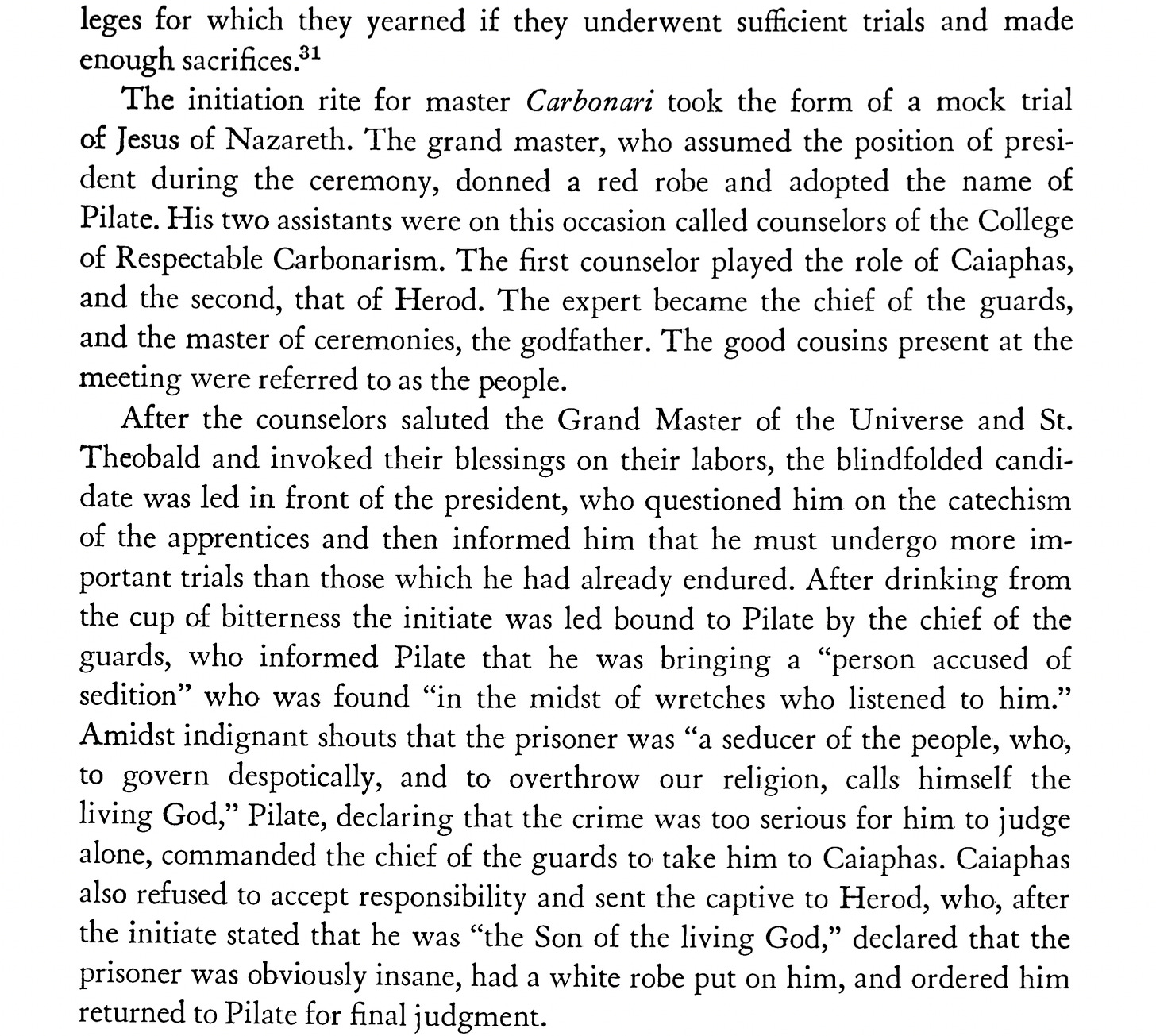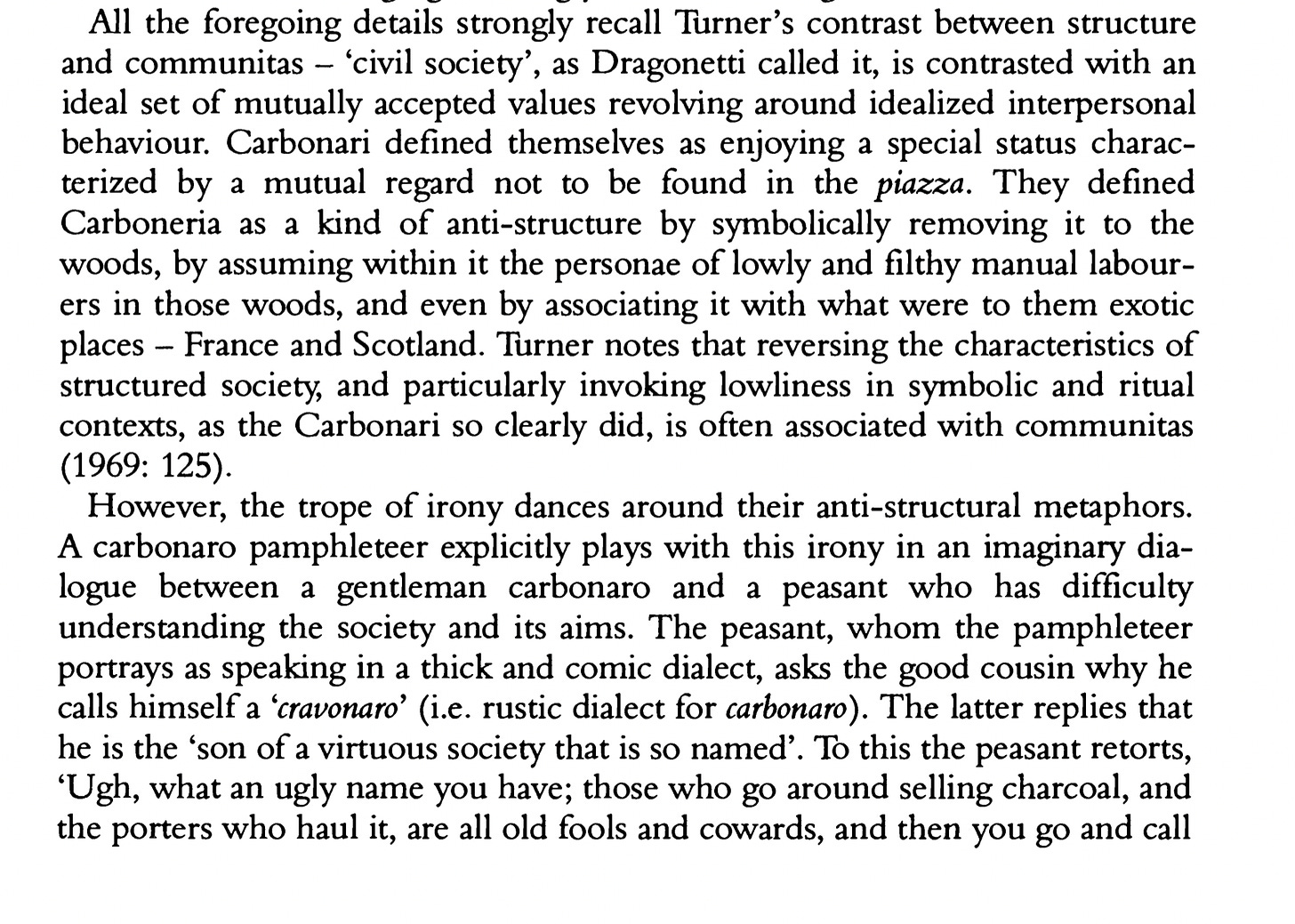Discover more from Pope Head Post
There exists nothing more sexy, nothing more seductive to the public imagination than that of the secret society. Cloaks and daggers, midnight plots, the whisper of an assassination. Occluded symbols hiding in plain sight. Prosaic authors deficient in both imagination and ability, (im looking at you Dan Brown) have profited off such thematic devices for decades. However, such secretive networks have existed and continue to exist, wielding enormous power over revolutionary movements. It is necessary to examine these societies with a sense of intellectual sobriety, so that we avoid chasing phantoms. The society which we will be examining today is known as the Carbonari, the charcoal makers, or charcoal burners. By examining them, we will end up with a better understanding of how such societies function and operate.
Like most secret societies, the origin of the Carbonari is a contentious topic, and this is of course by design. A secret society, whether political or esoteric, builds legitimacy by hinting at more ancient traditions. One legend links the Carbonari all the way back to Philip of Macedon, another to the patron saint of the organization, St Theobald. Others have speculated that they were in some way connected the Cathars of Southern France, as the Carbonari referred to each other as Buon Cugino (good cousin), reminiscent of the Albigensian bonhommes. In reality, the society is either of French, Italian, or possibly British origin. It was probably an offshoot of Freemasonry, or at least adopted many of its practices. Some scholars even believe it was organized by the Bavarian Illuminati (to the collective pant creaming of conspiracy theorists everywhere). The best explanation I can find is that “the Carbonari were a "popular" Freemasonry created by liberal anti-Napoleonic Masons to serve as a vehicle to arouse the uneducated masses in southern Italy against the French.” The Carbonari were far more egalitarian in their structure relative to 19th century masonic lodges, drawing members from a wide range of social classes.
The influence of the Carbonari paved the way for the Risorgimento, (Italian unification), and key elements would form into another revolutionary organization, La Giovine Italia, led by Mazzini, who was himself both a Carbonari and a mason. One notable initiate into the Carbonari, was Lord Byron himself. Many of the leaders of Italian unification were either initiated or directly affiliated with the organization. The Carbonari were champions of liberalism and Italian nationalism, professing a desire for either constitutional monarchism or republicanism, and were heavily involved in the revolution of 1820. It is not the aims of this article to give a comprehensive overview of the political activities of the Carbonari, but instead examine their rituals and initiation ceremonies, and analyze the broader implications of them. I will be drawing mostly from three papers that I will link at the end of this article.
The carbonari supposedly had two grades (at least initially, it seems by the 1820s this expanded to between 7 and 9 degrees), the lower and the higher. Admission to the first grade was altogether easy to obtain, as no important information was imparted to them. The goal was to have a large and organized body of men at the beck and call of their superiors. The meeting place of the Carbonari and the ritual context surrounding stands in stark contrast to that of their Masonic cousins.
Instead of the high ritualistic pomp of the Masonic lodge, the Carbonari met either literally or figuratively out in the forests. There is something deliciously pagan about the whole affair, meeting around a tree stump, straight out of a Puritans fever dreams of the witches Sabbath. It reminds me of stories of druids venturing out in the wilderness, looking to commune with ancient gods and practice bizarre rites. The irony being that Carbonari referred to non-Carbonari as “pagani,” pagans. This genius inversion likely entranced the commoners they were looking to attract.
Another stark contrast between High Masonry and the Carbonari is the latter’s incorporation of St Theobald into the ritualistic context. Masons at this time would balk at the suggestion of incorporating a Catholic saint so centrally into the ritualistic structure. But the Carbonari were appealing to the average southerner, whose folk beliefs and religiosity would have centered upon the Catholic Churches hierarchy of saints. A genius move of religious syncretism really.
Let’s take a look at the initiation ceremonies:
What is important to realize here, is that nothing in the ceremony would be too overtly offensive to a superstitious southern Italians Catholic sensibilities. Remember, there was a twofold division in the Carbonari, the lower and the higher. The common plebs of the first degree and the more advanced of the second degrees and beyond. The initiation into the second degree, added an element that would be seen as wholly sacrilegious to the majority of Catholics in Italy:
A lot to discuss here. While there was no open mocking of Christianity in this initiation, it certainly would have made the masses quite uncomfortable to see this kind of appropriation, and would have bordered on sacrilege. Here we also find another divide between Masonry and the Carbonari. The focus and appropriation of Christian symbols. Here we find the age old metaphysical mint of the gnostic, the printing of a counterfeit Christ. Christ is a carbonaro, and therefore Christs goals are the goals of liberal revolution. Christ is always referred to in Masonic terms as well, as “Grand Master of the Universe,” or the more Carbonari oriented “Good Cousin of the Universe.” Master Carbonari at this point were told that Christ was the first Carbonaro, and his 12 disciples the first Carbonari. “The aim was obviously not to make good Christians, but to make good Christians into good Carbonari!”
However, some more radical lodges went even further with the symbolism of the second grade:
The conception that all tyrants must be crucified and destroyed in the same manor that Christ was is obviously antithetical to core tenants of Orthodox Christianity. Here our Counterfeit Christ becomes blood thirsty, ravenous. He desires for his enemies to be subjected to the same torments that he was subjected too.
And this was only in the second degree. The higher degrees, the societies elites, had an altogether higher purpose:
The flesh of the lamb covering the wolfs matted hair. The unsuspecting plebs lured into revolutionary cells with exotic and yet benign rituals, excited by talk of revolution, drunk on the elixir of higher ideals: liberty, freedom. All under the auspices of an obscure Catholic saint. From there the Counterfeit Christ is introduced, the goals of the society are the goals of Christ. And yet the upper echelons know the truth, that the Good Cousin of the Universe is actually the Ruler of the World. Lucifer masquerades as an Angel of Light. The poor Southerners, who believed they were merely fighting for liberal ideals, were but cogs in far darker machinations.
The Carbonari were instrumental to Italian unification. That name, Giuseppe Mazzini, belonged to high grades of the society, and would have undoubtably been in on the higher goals. Mazzini, along with Garibaldi, two of the central figures of the Risorgimento were directly related to the Carbonari. Mazzini was also a freemason, showing how a member of one secret society was also frequently initiated into others. Now what did these poor southern Italians get roped into accomplishing? Italian unification was a disaster for southern Italy. Before unification, both the north and the south were on similar footing economically. The great success of the northern regions and the now terrible poverty of the south is usually blamed on the industrialization of the north and the souths failure to do so. But this was not just a random cast of the die. The leaders of the Risorgimento by and large had contempt for the southerners. Nino Bixio, General and hero of the revolution, had this to say about the south in one of his private letters. "In these regions it is not enough to kill the enemy, it is necessary to torment them, to burn them alive in a slow flame... they are regions that need to be destroyed or at least depopulated, their people sent to Africa to become civilized.”
If the average, God fearing 19th century Italian knew of the bizarre anti christian rites performed by the architects of the Risorgimento, if he knew that the true aims of many of these societies was the destruction of the Church, he would have fought bitterly against such a project. And yet as these things come to light in the 21st century, the Italian looks at the rites of the Carbonari with but a mild fascination, a passing curiosity. The ultimate sign of the Charcoal burners victory. If one wishes to see the origins of the modern Italian state, they should not venture to the grand marble column of the old Forums, no, they must go into the country side, where the dense forest clears, and find an old tree stump. The history of modern Italy was founded there.
There is one more point I would like to touch on, that may further elucidate our current situation. It is found in the supposed anti-structure of the Carbonari:
The Charcoal makers egalitarian environment, actually helped further entrench societal hierarchies outside of the vendita. And what were the fruits of the the Risorgimento? An Italy as hierarchal as ever, with the southerners humiliated and disgraced. A northern saying says, when a Milanese flushes the toilet, the shit flows down to Rome.
I cannot help but draw parallels with the Catholic Church today, and the Synod on Synodality. “The new church has no hierarchy, we are here for the poor! Like Christ! We want to involve everyone in the decisions of the Church!” And yet in reality, power structures are simply reified, corruption deepens, evil festers, all under the guise of a new egalitarianism. Parallels can be found everywhere, hell take any Communist country anywhere. Poor saps roped into carrying out the perverted dreams of perverted men. The occult underpinnings of political revolution.
Beware of Counterfeit Christs.
Beware of rich men who burn charcoal at night.
“And no wonder, for even Satan disguises himself as an angel of light.”
(2 Corinthians 11:14)
Subscribe to Pope Head Post
Papal history and deep topography.


































Another great piece of writing! This is why I subscribe. Keep it up friend.